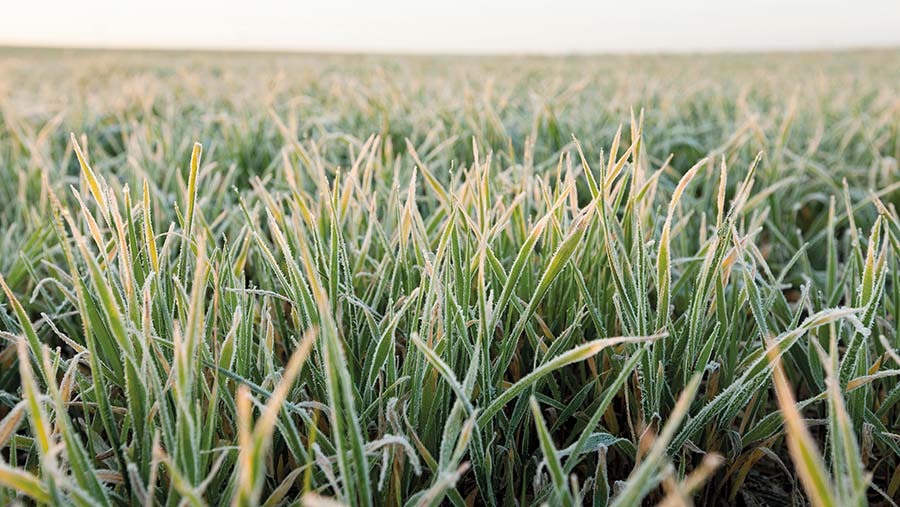5 tips to tailor wheat fungicides to variable spring weather
 © Rsooll/Adobe Stock
© Rsooll/Adobe Stock Unpredictable spring weather is just one of the unknowns faced by wheat growers ahead of the new growing season, as they plan fertiliser, fungicide and plant growth regulator use.
Balancing the effects of rainfall and temperature on crop growth and any disease epidemic with rising input costs, changes to variety resistance ratings and market volatility is the challenge for 2022, regardless of whether it’s a wet or a dry spring.
Farmers Weekly asked some experts for their tips from the past two years.
See also: Two new fungicides to fight septoria in wheat grower’s plans
1. Septoria complacency
Slow disease progression in the cold, dry April of 2021 didn’t prevent septoria reaching high levels by the end of the season, points out Chloe Morgan of Adas, who ran the AHDB/Adas fungicide challenge and saw some large yield responses from appropriate fungicide use.
“We had different responses regionally, but the overall picture is that a higher spend was justified, even after such a quiet start,” she reports. “By June, more septoria was seen than in previous years.”
Average spend on fungicides in the challenge was between £78/ha and £97/ha, according to region, with the North East and South West being at the higher end.
“Another observation from the challenges was that the better-performing fungicide programmes all had multisites included in them.”
2. Effect of cold, dry April
There is no doubt that spring 2021 was unusual, says Joe Bagshaw, field technical manager with Syngenta, who reveals that April average temperatures were at a 30-year low in the Midlands and there were 16 days with frosts, compared with an average of 3.9 days.
“Crops stood still as it was also dry,” he says. “The effect was to suppress any disease and slow it right down – septoria development is pushed back by two weeks if it doesn’t rain in April.”
When spring conditions are in its favour, septoria soon makes its presence felt, as overwintered inoculum is rarely limiting, he notes.
“It was slow to get going last year, so fungicide programmes were adapted accordingly. That’s why some ended up chasing the disease.”
3. Rain and timings
Septoria spreads by rain-splash and physical contact between the leaves, so April and May are key months for its development.
Specifically, the window between 16 April and 13 May is the most significant, according to the Syngenta trials database.
“If it rains in that window, we know the disease is going to spread,” says Mr Bagshaw. “It puts the emphasis on a good, persistent T1 to stop disease transfer up the plant, or there’s a risk you will be in a curative situation by T2.”
An added complication for 2022 is that many of the variety resistance ratings for septoria have shifted, so ratings should only be used as a guide for disease risk, he adds. “Monitor your crops and know what the risks are.”
4. Yellow rust threat
Yellow rust is different, as the spores are wind-blown and the pathogen has become very diverse, with new races being identified in recent years, says Mr Bagshaw.
Despite an improvement in variety resistance ratings, the disease is on an upwards trend, with later-drilled crops being more at risk.
The advice to deal with yellow rust as soon as it is active in crops is unchanged, with early control from a T0 being necessary in that situation, he says.
“After that, in the right conditions, yellow rust can cycle in just seven days. Again, the T1 choice can really make a difference.”
AHDB dose response work confirms that Elatus Era (benzovindiflupyr + prothioconazole) has the edge on rusts. “It also has the SDHI element that helps to limit septoria spread, so it is a good fit at T1,” he says.
5. Fungicide programme
Start with a rust active T0, if required. Then make good use of multisites for resistance management, opt for a persistent T1 and keep your strongest firepower for T2, advises Mr Bagshaw.
“The aim is to keep your main yield-building leaves clean,” he stresses. “Where nitrogen has been reduced, there may be some flexibility with fungicide rates, depending on disease pressure.”
Spray timing can be just as important as product choice and application should be optimised.
“We suggest using angled nozzles for T0 applications and vertical air inclusion nozzles at T1 and T2, when you need to force the droplets into the canopy.”
Agronomist’s view
Don’t underestimate what the weather can do and how quickly things can change, warns Zantra’s technical director, Chris Bean.

Chris Bean © MAG/Barry Myles
Exceptionally dry conditions in spring 2020 saw growers put large quantities of nitrogen fertilisers on in March, only for crops to go flat later in the season after plant growth regulators (PGRs) were omitted and the nitrogen eventually made its way into the plants, he recalls.
“Even where nitrogen use was more sensible, crops still went flat because the reduced PGR programmes adopted just weren’t strong enough.”
Last year’s dry spell early in the season saw growers omit T0s and cut back on T1s, only for septoria to develop after rain in May, continuing through June and July in some areas, putting T2 applications under pressure.
Heavy rain and rising temperatures two weeks ahead of the T2 application meant that the 220-day degrees required for septoria to cycle was reached quickly, he explains, so the disease exploded.
“At that point, we realised that there was a problem in varieties with the Cougar gene,” he says.
“Their resistance ratings have since been downgraded, but mean figures for the whole of the UK don’t tell us everything about variety performance on a local basis.”
Lower scores
His advice for 2022 is that varieties with lower septoria scores and good yield potential should be looked after.
“Varieties with two-way Cougar parent lines, such as Saki, Merit and Firefly, are at greater risk than the three-way ones, which include Astronomer and Rashid.”
Use the revised one-year septoria ratings, rather than the three-year scores, and remain vigilant for both septoria and yellow rust, says Mr Bean.
“There is rust in crops already and we know that it is still a very dynamic situation, despite seeing very little of it last year. With later drilling still in vogue, remember that yellow rust pressure increases.”
There are situations where fungicide and PGR reductions will be possible, he accepts, as cutting back on fertiliser inputs will reduce disease pressure is some crops and alter the need for growth regulation. The expected 5-10% price increase in agrochemicals also has a bearing.
“There’s a choice between changing products or tweaking rates. Much will depend on your attitude to risk and the yield potential of your crops.”
Group 2 variety Extase, which accounts for about 15% of the acreage, showed a significant response to fungicides in Zantra trials last year, despite its good disease resistance ratings.
“T1 cuts are risky with Extase, with its eyespot rating of 3, and it is one of the taller varieties, so have a plant growth regulator plan for that,” he says.
“As there are 13% protein contracts for Extase this year and premiums are at high levels, growers may want to push it.”
Turns wet
If it turns wet as the season progresses, higher fungicide rates may be required. With products such as Univoq (fenpicoxamid + prothioconazole) available, it’s possible to do almost as good a job by using 1.5 litres/ha rather than 1.25 litres/ha if the T2 is delayed.
“There’s always debate about the use of a T0, but it does get you off to a good start,” he concludes.
“Even last year we saw an average response of 0.25t/ha to that spray timing; this year there are plenty of crops and stubbles with disease in them already.
“In most varieties, you will probably be in the crop anyway with the first plant growth regulator treatment.”

